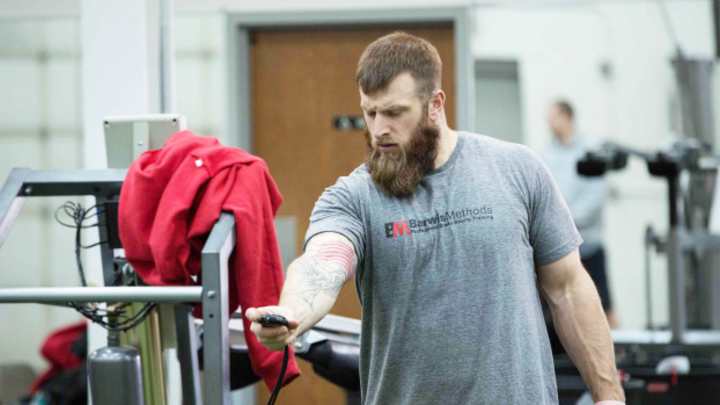Pro Trainer Mike Barwis Tells How to Get Big-Time 'American Muscle'

Mike Barwis’ quad muscles are famous. He’s been in the gym with elite athletes from more than 40 different sports, including Seattle Seahawks cornerback Richard Sherman, NHL defenseman Jack Johnson and UFC fighter Rashad Evans, but Barwis isn’t one of the professional athletes – he’s their trainer.
Barwis credits his truly rock-hard quads to genetics, but as a former director of strength and conditioning for West Virginia University and the University of Michigan, he knows better than anyone how vigorous training, intensity and pure hard work can transform an athlete’s body. As founder and CEO of Barwis Methods training centers, located in three cities in Michigan, the 41-year-old develops specialized programs using science-based methods to get results his clients can see.
“Where I first started training with Mike I weighed 300 pounds,” says Brandon Graham, former Michigan Wolverines defensive end and current linebacker for the Philadelphia Eagles. “Now I weigh 265 pounds. You tell him what you want to do and he will work you towards that goal.”

As the face of the Discovery Channel’s new series American Muscle, Barwis is bringing the cameras into his gym to show how he uses his degrees in exercise physiology and athletic training to apply science to his training programs. Barwis, who taught at the WVU School of Physical Education for 10 years, says that he designs his programs based on cellular adaptation, or the changes made by cells in response to adverse environmental changes. Each athlete and sport involves different scenarios and energy requirements, so he focuses on providing a specific stimulus to accommodate the change that is necessary. To monitor and accurately develop the workouts, Barwis utilizes fitness-tracking technology, like the TENDO Unit device, which measures velocity and power output and can determine whether an athlete has slow- or fast-twitch muscle fibers.
Relentless Attack: How Tim Grover Became One of the NBA's Most Revered Trainers
“The way we design our conditioning phases is based on the bioenergetics of how a person utilizes their fuels to function in a sport, which is very different for each,” says Barwis in his distinctly raspy tone. “In soccer you run, react, accelerate and decelerate the whole game, whereas in football you're seven seconds on and off, and in hockey it can be 30 seconds of absolute intensity and then a small break.”
Barwis’ methodical approach also includes special diets and supplements. The athletes operate on a schedule that involves food, training and recovery so “they don’t have to think – the science is all set up for them and everything is mapped out so they just need to bring the intensity,” says Barwis. He also focuses on the biomechanical positions, or the little cues of weight-lifting, to make sure his athletes aren’t committing what he says is the most common lifting mistake: undertraining the posterior side of the muscles. He says most people only focus on the anterior – “I’m jumping a lot so I should work on my quads” – but they neglect the gluteus and hamstring muscles and subject themselves to injury.
Dan Mozes is vice president of operations and head strength coach at Barwis Methods, but he used to experience Barwis’ training first-hand as a four-year starter for the WVU football team. He believes Barwis’ conditioning methods helped him to win the Rimington Trophy in 2006, awarded to college football’s best center.

Ask any of Barwis’ trainees about his hardest, most feared workout, and they’ll all agree: it’s hypertrophy. One of the five major types of cellular adaptation, hypertrophy’s technical definition is an increase in cell size, but Barwis’ definition is “legitimate hell,” in order to increase the cross-sectional area of the muscle fibers, or muscle mass.
“Every year it was awlful,” Mozes recalls. “But if you ask any athlete what was the worst part and the best part, they’ll say hypertrophy, because if you can get through that you can get through anything on the field.”
His hypertrophy phase involves very little rest, high repetitions until failure and “usually a lot of vomit, muscular fatigue, cramping and people collapsing,” says Barwis. In one part of the phase, an athlete may do four sets of squats for 12 repetitions until absolute fatigue, and then 10 jump squats immediately after before returning to the rack for a second set, without rest. That set is then followed by lunges for 30 yards and then step-ups – and upon completion, the athlete moves on to a shoulder workout in a similar format.
“The top athletes in the world are on their knees – it’s a beast,” says Barwis, who won’t assign a workout if he can’t complete it. “It prepares you physically and mentally – you understand that if I can go through this, there is nothing in the sport that I can't handle. And there's nothing in life I can't handle either.”
The Discovery Channel’s American Muscle premieres Wednesday, July 9 at 9pm/8c.
Get Mike Barwis' best exercise and lifting tips for building muscle:
